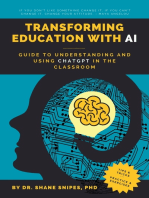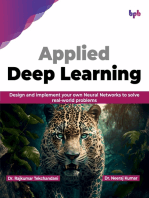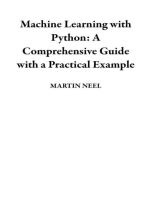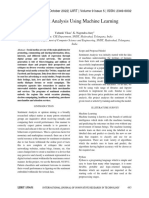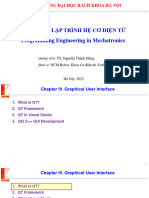Twitter Sentiment Analysis Using Python TweetX
Uploaded by
Alexander DidenkoTwitter Sentiment Analysis Using Python TweetX
Uploaded by
Alexander DidenkoInternational Journal of Scientific Research in Engineering and Management (IJSREM)
Volume: 08 Issue: 04 | April - 2024 SJIF Rating: 8.448 ISSN: 2582-3930
Twitter Sentiment Analysis using Python (TweetX)
Vijayalaxmi Tadkal1, Ajit Yadav2, Amit Ghaytadake3, Vivek Salwalkar4, Mahesh Yadav5
1Asst Prof Department of Computer Science Engineering [AIML] & IETE’S Bharat College of Engineering
2 BE Department of Computer Science Engineering [AIML] & IETE’S Bharat College of Engineering
3BE Department of Computer Science Engineering [AIML] & IETE’S Bharat College of Engineering
4 BE Department of Computer Science Engineering [AIML] & IETE’S Bharat College of Engineering
5 BE Department of Computer Science Engineering [AIML] & IETE’S Bharat College of Engineering
---------------------------------------------------------------------***---------------------------------------------------------------------
Abstract - Twitter has become a significant platform for researching about. . modifying GANs and applying conditions
expressing opinions and emotions on a wide range of topics. on them isn’t limited to just generating images, we can use it to
This study presents a comprehensive analysis of sentiment create passwords that are very hard to crack and numerous
expressed in Twitter data using natural language processing similar applications like this.
and machine learning techniques. The primary objective is to
gauge public sentiment on various subjects, from politics to
brand perception, by analysing tweets. We collected a vast 2. EXISTING SYSTEM
dataset of tweets, pre-processed the text, and employed PyTorch is a popular Py lib for d learning and MLearning .
sentiment analysis algorithms to classify tweets as positive,
PyTorch can be used to build a variety of image generators,
negative, or neutral. The results provide valuable insights into
public sentiment trends, allowing businesses, policymakers, including (GAN) and (VAEs).
and researchers to make informed decisions based on the TensorFlow is another popular Python library for deep learning
collective voice of Twitter users. The study demonstrates the and ML. TensorFlow can also be used to build a variety of
potential of sentiment analysis as a tool for understanding image generators, including GANs and VAEs.
public sentiment and monitoring real-time public opinion
Jax is a relatively new Python library for mL learning and dL
Key Words: (NLTK), TextBlob learning. Jax is gaining popularity due to its ease of use and
flexibility. Jax can also be used to build a variety of image
generators.
1.INTRODUCTION
3. LITERATURE REVIEW
For a human mind it is very easily too thin of new content. what
if someone asks you to “draw a flower with blue petals”. It is To understand how to generate content required an extensive
very easy for us to do that. but machines process information study of Deep Learning and Unsupervised learning and to do
very differently. Just understanding the structure of the above that we used various Books and Publication along with Some
sentence is a difficult task for them let alone generate something Blogs, Talks and Conferences.Pre-process the words into
based on that description. Automatic synthetic content embedding. Taking in input as a word and do proper
generation is a field that has been explored in the past and was tokenization. Creating an LSTM Model and generating
discredited because at that time neither the algorithms existed embedding using the model. Using a LSTM model, we need to
nor enough processing power that could help solve the problem. convert the long sentence description into a word embedding to
However, the advent of deep learning started changing the pass it into the generator Pre-processing the image and using
earlier beliefs. The tremendous power of neural networks to proper techniques to normalize them. Normalizing and
capture the features even in the humongous of datasets makes augmenting the images using own methods in jumpy.
them a very viable candidate for automatic content generation.
another milestone milestone was achieved when Ian Good 1)Natural Language Processing with Python by Steven Bird
Fellow proposed generative adversarial networks in 2014.
GANs are a kind of architecture in Deep learning that can In this book I got familiarized with a lot of tools and techniques
produce content from random noise. What is even more unique to process words and the Overall field of Natural Language
about GANs is that the content they create represents the dataset Processing and the best practices to properly process my Input
on which they are being trained upon but it is totally unique in
some way or the other. Generating an image from a text-based 2)Neural Networks and Deep Learning by Michael Nielsen
description is one aspect of generative adversarial networks that
we will focus upon. Since the GANs follow unsupervised In this book I studied various architectures of Deep Learning
learning approach we have modified them to take am input as a that are most commonly used today along with proper
condition and generate based on the input condition. This can techniques to train the models and steps to avoid overfitting and
form base for a large number of things like synthetic audio underfitting .
generation like the ones used in Siri or assistant, video content 3)Generative Adversarial Networks by Ian Goodfellow
generation from just scripts. imagine entire movies made out of
just the script. These are some uses that many companies are
© 2024, IJSREM | www.ijsrem.com DOI: 10.55041/IJSREM31058 | Page 1
International Journal of Scientific Research in Engineering and Management (IJSREM)
Volume: 08 Issue: 04 | April - 2024 SJIF Rating: 8.448 ISSN: 2582-3930
Ian Goodfellow is the creator of Generative Adversarial 5.Architecture & Data flow diagram
Networks and this publication helped me understand what
GANs are, how they function and more importantly how can
they even do what they do. Also Introduced me to some
Problems like Mode Collapse.
4. METHODOLOGY
HTML, is the commonly used language for creating and
structuring content on the site ,HTML helps organize
information through elements like headings, paragraphs, and
lists. It allows for the inclusion of hyperlinks to navigate
between sections or external sources. HTML also supports
multimedia integration, ensures accessibility, aids
discoverability through metadata, and enables interactivity for
engaging readers. Overall, HTML serves as a fundamental tool
for presenting research effectively online.
CSS is a sheet-style language used to define the appearance Fig 1: Architecture
and format of a markup document. It gives HTML a
supplementary function. Used with HTML, the style of user
interfaces and webpage is changed. It may also be used in XML Data Flow Diagram
documents of any form, including simple XUL, SVG and XML
documents. In most websites, CSS is used with HTML and
JavaScript to develop web-based user interfaces and user
interfaces for a variety of mobile applications. What CSS
accomplishes is: you can add unique appearances to your
HTML pages, modify the style with just a few modifications to
CSS code. C.S.S. is used in the creation of HTML Tags. C.S.S.
is used widely used as a web language, to create a web page,
we usually use H.T.M.L., C.S.S. and JavaScript. CSS is also a
commonly used language in Cascading Style sheet. It allows
web developers to use HTML tags for styling.
JavaScript or JS is an object oriented light weight language
used for web page scripting by various online sites. The HTML
document is a fully interpreted computer language allowing
interactivity dynamically on web pages. In 1995, it was
launched to add software to Netscape Navigator's web pages.
All other graphical web browsers have been embraced since
then. Users may construct contemporary web applications with
JavaScript so that they can interact without refreshing the page
at all times. Js is used in the conventional website for various
sorts of easiness and interaction
Backend Technologies
Python is a commonly used programming language celebrated
for its simplicity, readability, and adaptability across various
domains. Its intuitive syntax and dynamic typing make it easy
to learn and use, appealing to beginners and experienced
developers alike. Python's interpreted nature allows for
interactive testing and debugging, fostering rapid development
cycles. With a vast common library and a thriving ecosystem
of third-party packages, Python is well-suited for diverse
applications, Its cross-platform compatibility ensures seamless
execution on different operating systems, while its strong
community support and governance by the Python Software
Foundation ensure continuous growth and evolution. Overall, Fig 2: Data Flow Diagram
Python's versatility and extensive resources developers tackling
a big range of projects.
© 2024, IJSREM | www.ijsrem.com DOI: 10.55041/IJSREM31058 | Page 2
International Journal of Scientific Research in Engineering and Management (IJSREM)
Volume: 08 Issue: 04 | April - 2024 SJIF Rating: 8.448 ISSN: 2582-3930
6.RESULT 7. CONCLUSION
In conclusion, Twitter pole analysis is a powerful tool with a
big range of applications and a promising future. It allows
businesses, governments, researchers, and individuals to gain
valuable insights into public opinion and emotions expressed
on the platform. By harnessing the vast amount of data
available on Twitter, sentiment analysis provides numerous
benefits.
REFERENCE
[1] M. Arlovski and L. Bottou. Towards principled methods for
training generative adversarial networks. In ICLR, 2017.
Fig 3: Signup Page [2] A. Brock, T. Lim, J. M. Ritchie, and N. Weston. Neural photo
editing with introspective adversarial networks. In ICLR, 2017.
[3] T. Che, Y. Li, A. P. Jacob, Y. Bagnio, and W. Li. Mode
regularized generative adversarial networks. In ICLR, 2017.
[4] X. Chen, Y. Duan, R. Houthooft, J. Schulman, I. Sutskever, and
P. Abbeel. Infogan: Interpretable representation learning by
information maximizing generative adversarial nets. In NIPS, 2016.
[5] E. L. Denton, S. Chintala, A. Szlam, and R. Fergus. Deep
generative image models using a laplacian pyramid of adversarial
networks. In NIPS, 2015.
[6] C. Doersch. Tutorial on variational autoencoders.
arXiv:1606.05908, 2016.
Fig 4: Login page [7] J. Gauthier. Conditional generative adversarial networks for
convolutional face generation. Technical report, 2015.
[8] K. He, X. Zhang, S. Ren, and J. Sun. Deep residual learning for
image recognition. In CVPR, 2016.
[9] X. Huang, Y. Li, O. Poursaeed, J. Hopcroft, and S. Belongie.
Stacked generative adversarial networks. In CVPR, 2017.
Fig 5: Home page
Fig 6: Result
© 2024, IJSREM | www.ijsrem.com DOI: 10.55041/IJSREM31058 | Page 3
You might also like
- Advanced Deep Learning with Python: Design and implement advanced next-generation AI solutions using TensorFlow and PyTorchFrom EverandAdvanced Deep Learning with Python: Design and implement advanced next-generation AI solutions using TensorFlow and PyTorchNo ratings yet
- Transforming Education with AI: Guide to Understanding and Using ChatGPT in the ClassroomFrom EverandTransforming Education with AI: Guide to Understanding and Using ChatGPT in the ClassroomNo ratings yet
- Modern Tkinter for Busy Python Developers: Quickly Learn to Create Great Looking User Interfaces for Windows, Mac and Linux Using Python's Standard GUI ToolkitFrom EverandModern Tkinter for Busy Python Developers: Quickly Learn to Create Great Looking User Interfaces for Windows, Mac and Linux Using Python's Standard GUI ToolkitNo ratings yet
- Codehs: Mobile Apps Course Syllabus One Year For High School (125 Contact Hours)No ratings yetCodehs: Mobile Apps Course Syllabus One Year For High School (125 Contact Hours)8 pages
- Internet of Things (IoT) A Quick Start Guide: A to Z of IoT EssentialsFrom EverandInternet of Things (IoT) A Quick Start Guide: A to Z of IoT EssentialsNo ratings yet
- The Newbie’s Guidebook to ChatGPT: A Beginner's Tutorial: The Newbie’s GuidebookFrom EverandThe Newbie’s Guidebook to ChatGPT: A Beginner's Tutorial: The Newbie’s GuidebookNo ratings yet
- Deep Learning for Beginners: A Comprehensive Introduction of Deep Learning Fundamentals for Beginners to Understanding Frameworks, Neural Networks, Large Datasets, and Creative Applications with EaseFrom EverandDeep Learning for Beginners: A Comprehensive Introduction of Deep Learning Fundamentals for Beginners to Understanding Frameworks, Neural Networks, Large Datasets, and Creative Applications with Ease2.5/5 (2)
- Neural Networks: A Practical Guide for Understanding and Programming Neural Networks and Useful Insights for Inspiring ReinventionFrom EverandNeural Networks: A Practical Guide for Understanding and Programming Neural Networks and Useful Insights for Inspiring ReinventionNo ratings yet
- Graph Data Science with Python and Neo4j: Hands-on Projects on Python and Neo4j Integration for Data Visualization and Analysis Using Graph Data Science for Building Enterprise StrategiesFrom EverandGraph Data Science with Python and Neo4j: Hands-on Projects on Python and Neo4j Integration for Data Visualization and Analysis Using Graph Data Science for Building Enterprise StrategiesNo ratings yet
- Graph Data Science with Python and Neo4j: Hands-on Projects on Python and Neo4j Integration for Data Visualization and Analysis Using Graph Data Science for Building Enterprise Strategies (English Edition)From EverandGraph Data Science with Python and Neo4j: Hands-on Projects on Python and Neo4j Integration for Data Visualization and Analysis Using Graph Data Science for Building Enterprise Strategies (English Edition)No ratings yet
- Hands-on TinyML: Harness the power of Machine Learning on the edge devices (English Edition)From EverandHands-on TinyML: Harness the power of Machine Learning on the edge devices (English Edition)5/5 (1)
- CODING FOR ABSOLUTE BEGINNERS: How to Keep Your Data Safe from Hackers by Mastering the Basic Functions of Python, Java, and C++ (2022 Guide for Newbies)From EverandCODING FOR ABSOLUTE BEGINNERS: How to Keep Your Data Safe from Hackers by Mastering the Basic Functions of Python, Java, and C++ (2022 Guide for Newbies)No ratings yet
- Deep Learning With Python Illustrated Guide For Beginners & Intermediates: The Future Is Here!: The Future Is Here!, #2From EverandDeep Learning With Python Illustrated Guide For Beginners & Intermediates: The Future Is Here!: The Future Is Here!, #21/5 (1)
- TensorFlow Developer Certification Guide: Crack Google's official exam on getting skilled with managing production-grade ML modelsFrom EverandTensorFlow Developer Certification Guide: Crack Google's official exam on getting skilled with managing production-grade ML modelsNo ratings yet
- Basics of Python Programming: Learn Python in 30 days (Beginners approach) - 2nd EditionFrom EverandBasics of Python Programming: Learn Python in 30 days (Beginners approach) - 2nd EditionNo ratings yet
- Machine Learning in Production: Master the art of delivering robust Machine Learning solutions with MLOps (English Edition)From EverandMachine Learning in Production: Master the art of delivering robust Machine Learning solutions with MLOps (English Edition)No ratings yet
- Building Transformer Models with PyTorch 2.0: NLP, computer vision, and speech processing with PyTorch and Hugging Face (English Edition)From EverandBuilding Transformer Models with PyTorch 2.0: NLP, computer vision, and speech processing with PyTorch and Hugging Face (English Edition)No ratings yet
- Pythonic AI: A beginner's guide to building AI applications in Python (English Edition)From EverandPythonic AI: A beginner's guide to building AI applications in Python (English Edition)5/5 (1)
- Literature Review On Vulnerability Detection UsingNo ratings yetLiterature Review On Vulnerability Detection Using10 pages
- Machine Learning Upgrade: A Data Scientist's Guide to MLOps, LLMs, and ML InfrastructureFrom EverandMachine Learning Upgrade: A Data Scientist's Guide to MLOps, LLMs, and ML InfrastructureNo ratings yet
- What Is Natural Language Processing (NLP)No ratings yetWhat Is Natural Language Processing (NLP)15 pages
- Applied Deep Learning: Design and implement your own Neural Networks to solve real-world problems (English Edition)From EverandApplied Deep Learning: Design and implement your own Neural Networks to solve real-world problems (English Edition)No ratings yet
- Building AI Applications with Microsoft Semantic Kernel: Easily integrate generative AI capabilities and copilot experiences into your applicationsFrom EverandBuilding AI Applications with Microsoft Semantic Kernel: Easily integrate generative AI capabilities and copilot experiences into your applicationsNo ratings yet
- IoT Data Analytics using Python: Learn how to use Python to collect, analyze, and visualize IoT data (English Edition)From EverandIoT Data Analytics using Python: Learn how to use Python to collect, analyze, and visualize IoT data (English Edition)No ratings yet
- Mastering Python Networking - Third Edition: Your one-stop solution to using Python for network automation, programmability, and DevOps, 3rd EditionFrom EverandMastering Python Networking - Third Edition: Your one-stop solution to using Python for network automation, programmability, and DevOps, 3rd Edition3/5 (2)
- Mastering ServiceStack: Utilize ServiceStack as the rock solid foundation of your distributed systemFrom EverandMastering ServiceStack: Utilize ServiceStack as the rock solid foundation of your distributed systemNo ratings yet
- Basic Guide to Programming Languages Python, JavaScript, and RubyFrom EverandBasic Guide to Programming Languages Python, JavaScript, and RubyNo ratings yet
- Data Science with Jupyter: Master Data Science skills with easy-to-follow Python examplesFrom EverandData Science with Jupyter: Master Data Science skills with easy-to-follow Python examplesNo ratings yet
- Python The Complete Reference: Comprehensive Guide to Mastering Python Programming from Fundamentals to Advanced TechniquesFrom EverandPython The Complete Reference: Comprehensive Guide to Mastering Python Programming from Fundamentals to Advanced TechniquesNo ratings yet
- A Greater Foundation for Machine Learning Engineering: The Hallmarks of the Great Beyond in Pytorch, R, Tensorflow, and PythonFrom EverandA Greater Foundation for Machine Learning Engineering: The Hallmarks of the Great Beyond in Pytorch, R, Tensorflow, and PythonNo ratings yet
- Parallel and High Performance Programming with Python: Unlock parallel and concurrent programming in Python using multithreading, CUDA, Pytorch and Dask. (English Edition)From EverandParallel and High Performance Programming with Python: Unlock parallel and concurrent programming in Python using multithreading, CUDA, Pytorch and Dask. (English Edition)No ratings yet
- Demystifying Large Language Models: Unraveling the Mysteries of Language Transformer Models, Build from Ground up, Pre-train, Fine-tune and DeploymentFrom EverandDemystifying Large Language Models: Unraveling the Mysteries of Language Transformer Models, Build from Ground up, Pre-train, Fine-tune and DeploymentNo ratings yet
- Mastering TensorFlow 2.x: Implement Powerful Neural Nets across Structured, Unstructured datasets and Time Series DataFrom EverandMastering TensorFlow 2.x: Implement Powerful Neural Nets across Structured, Unstructured datasets and Time Series DataNo ratings yet
- PYTHON DATA ANALYTICS: Mastering Python for Effective Data Analysis and Visualization (2024 Beginner Guide)From EverandPYTHON DATA ANALYTICS: Mastering Python for Effective Data Analysis and Visualization (2024 Beginner Guide)No ratings yet
- Python Data Visualization Essentials Guide: Become a Data Visualization expert by building strong proficiency in Pandas, Matplotlib, Seaborn, Plotly, Numpy, and BokehFrom EverandPython Data Visualization Essentials Guide: Become a Data Visualization expert by building strong proficiency in Pandas, Matplotlib, Seaborn, Plotly, Numpy, and BokehNo ratings yet
- Machine Learning with Python: A Comprehensive Guide with a Practical ExampleFrom EverandMachine Learning with Python: A Comprehensive Guide with a Practical ExampleNo ratings yet
- Building LLM Powered Applications: Create intelligent apps and agents with large language modelsFrom EverandBuilding LLM Powered Applications: Create intelligent apps and agents with large language modelsNo ratings yet
- Automatic Image Annotation: Enhancing Visual Understanding through Automated TaggingFrom EverandAutomatic Image Annotation: Enhancing Visual Understanding through Automated TaggingNo ratings yet
- Hands-on Data Analysis and Visualization with Pandas: Engineer, Analyse and Visualize Data, Using Powerful Python LibrariesFrom EverandHands-on Data Analysis and Visualization with Pandas: Engineer, Analyse and Visualize Data, Using Powerful Python Libraries5/5 (1)
- Python Text Mining: Perform Text Processing, Word Embedding, Text Classification and Machine TranslationFrom EverandPython Text Mining: Perform Text Processing, Word Embedding, Text Classification and Machine TranslationNo ratings yet
- Data Structures and Algorithms with Go: Create efficient solutions and optimize your Go coding skills (English Edition)From EverandData Structures and Algorithms with Go: Create efficient solutions and optimize your Go coding skills (English Edition)No ratings yet
- Market Data Synchronisation in R-Project: 1 Plain TextNo ratings yetMarket Data Synchronisation in R-Project: 1 Plain Text3 pages
- Cultural Values and Economic Growth in Asia: An Empirical AnalysisNo ratings yetCultural Values and Economic Growth in Asia: An Empirical Analysis13 pages
- CSC Assessment 1 - 2024 25 - V141024 - Assessment Brief Form 2024-25No ratings yetCSC Assessment 1 - 2024 25 - V141024 - Assessment Brief Form 2024-2512 pages
- Chapter IV. Graphical User Interface QTNo ratings yetChapter IV. Graphical User Interface QT107 pages
- Building Blocks of Responsive Web Design Author Allan Jerjas, Sten Andersson, Lansner AndersNo ratings yetBuilding Blocks of Responsive Web Design Author Allan Jerjas, Sten Andersson, Lansner Anders36 pages
- GitHub - HubSpotContentOffers - My - Site - New Files, New Content, Fixed Links, Minor Apearance and Behavior ChangesNo ratings yetGitHub - HubSpotContentOffers - My - Site - New Files, New Content, Fixed Links, Minor Apearance and Behavior Changes1 page
- Cambridge IGCSE: Information and Communication Technology 0417/03No ratings yetCambridge IGCSE: Information and Communication Technology 0417/038 pages
- (FREE PDF Sample) HTML5 Game Development by Example Beginner S Guide Second Edition Thomas Mak EbooksNo ratings yet(FREE PDF Sample) HTML5 Game Development by Example Beginner S Guide Second Edition Thomas Mak Ebooks49 pages



